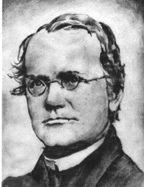 Johan Gregor Mendel 1822-1884. |
Charles Robert Darwin 1809-1882. |
 Johan Gregor Mendel 1822-1884. |
Charles Robert Darwin 1809-1882. |
Our discussion thus far has been dominated by the debate about the nature and significance of different sorts of variation, but before we proceed to look at what followed its resolution, we need to mention two important developments, the first of which antedates much of the argument. Though thus quite early, both developments belong more with the theoretical activities in the post-reconciliation period.
In 1908, both Hardy and Weinberg independently demonstrated the conditions for the stable genetic equilibrium that now goes under their name. Before this, it had been supposed, for example, that a genetically-dominant allele would, following its introduction to the population, spread until reaching a frequency of 0.5 to give the familiar 3:1 ratio. (This kind of misconception still persists among beginning students of population genetics: to make a point that will be repeated, the genetic dominance relationship among a given pair of alleles makes reference only to the phenotype of their heterozygote vis-a-vis the homozygote phenotypes; it says nothing about the fitness differences, if any, associated with the possession of one or other allele, and therefore nothing about any eventual changes in the frequencies of phenotypes.) The general message of the Hardy-Weinberg finding is that the mere passage of generations - successive episodes of meiosis and zygote formation - has no impact on genic variance (if you recall, loss of genetic variation was a serious problem for Darwin under his assumptions of blending inheritance.) To the contrary, genic variance can change only through sampling error (genetic drift), replication error (mutation) or differential reproduction (selection.) It is for this reason that the Hardy-Weinberg ratio provides an important benchmark for comparisons with empirical genic frequency information.
In 1915, Punnet published a book on Mimicry which contained a table, prepared by the mathematician Norton, which showed the speed with which a Mendelian factor, whether dominant or recessive, would spread under selection of various intensities. The table is remarkably modern in content and shows, in a crude way, the trajectories of allele frequencies under selection, which we shall meet soon.
By 1918, most people had drawn a preliminary conclusion that Mendelism and Darwinism were indeed complementary (to some good extent as a result of a seminal paper by Fisher), and over the next 15 years the discipline of population genetics took shape, as people slowly worked out the quantitative consequences of chance and selection in populations with Mendelian inheritance. This synthesis was largely carried out by Fisher, Haldane and Wright. As we shall see, their priorities and attitudes were very distinct, and they formed highly divergent views on how evolution "worked," especially in the cases of Fisher and Wright. They all agreed on the importance and efficacy of selection, but they left us with visions of the nature of populations and of the dynamics of the evolutionary process that are not obviously compatible. These differences remain, and still await resolution (but see Note 1).
Against this general background, Fisher, Haldane and Wright launched into their monumental synthetic works. They were all adept mathematicians, and we might note, in passing, that they (especially Fisher) single-handedly invented much of the basic statistical tool kit which we use today in genetic and biometric analysis. Much has been written about the (often rather bitter) 30-yr. intellectual conflict which developed between Fisher and Wright, and much, too, written on the sources of inspiration for their highly distinct models of population structure and the evolutionary process.
Historians of the ideas and the period have made persuasive arguments that many of the features which inspired and remained at the cores of these disparate views are owed to their authors' attitudes, assumptions, and beliefs about matters strictly outside of science - about life, the universe and everything - and it is therefore appropriate, given our remarks in the preamble, at least to sketch some of these claims. This we shall do, after having made a first acquaintance with the main ideas.
It is well worth stressing (and this will be repeated!) that their ideas developed at a time when virtually nothing was known about the genetic realities of natural populations: the theory was being developed on an extremely narrow empirical base. Indeed, until remarkably recently, one might say that theoretical population and evolutionary genetics was a large pyramid of argument resting not-so-firmly on its apex. To be specific, almost nothing was known about magnitudes of allelic variability, of selection differentials, gene-flow, or population size & structuring. As we shall see, much of the argument about evolutionary processes persists because of our continuing empirical uncertainties.
FOOTNOTES
Note 1. Barton, N.H. & M. Turelli 1977 Perspective: A critique of Sewall Wright's Shifting Balance Theory of Evolution. Evolution 51: 643-671.